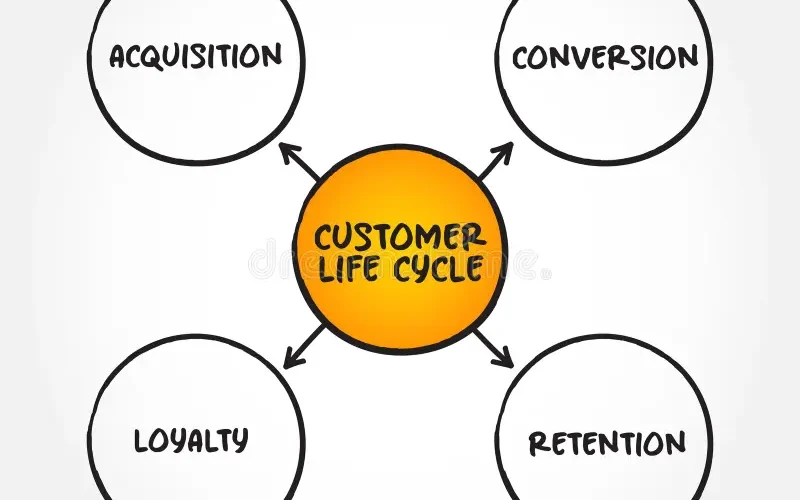You, as the owner of an online store, have probably heard a lot about the importance of maintaining happy customers. Success in retail likely hinges in large part on your ability to attract and satisfy customers, so it’s crucial to invest heavily in acquiring the expertise and tools necessary to respond quickly to market shifts. It’s commonly believed that the most loyal clients belong to the most prosperous companies. But if you want your company to succeed in building brand loyalty, you must first learn about your clients and how they found your website. In this article, we will discuss customer lifecycle stages, software, marketing techniques, and management.
What Is the Customer Lifecycle?
The customer lifecycle describes the process of customers being aware of a product, purchasing from a brand, and, ideally, becoming a long-term client. There are five stages to the customer cycle: reach, acquisition, conversion, retention, and loyalty.
To put it more simply, it describes the actions that a customer takes as they move through the flywheel and sales funnel. It shows marketing, sales, and customer support teams a complete customer journey and areas for improvement.
Your team may utilize the lifecycle to generate content for lead acquisition and to deliver customer experiences that satisfy customers at every stage by leveraging the lifecycle.
What Are the Customer Lifecycle Stages?
Every company has the same overarching objective: to turn visitors into paying customers. However, conversion rates aren’t the only metric that firms should care about. This is due to the fact that the leads your company generates may ultimately turn out to be of poor quality and make only a single purchase.
Customer lifecycle stages are identified as “reach,” “acquisition,” “conversion,” “retention,” and “loyalty” in a matrix devised by marketing experts Jim Sterne and Matt Cutler. To achieve this goal, one must first attract the attention of a potential consumer, then educate them on the company’s offerings, convert them into paying customers, and finally retain them as loyal customers whose enthusiasm for the product or service encourages others to purchase it themselves.
Customer retention is a cycle, and good CRM encourages return visits from customers at all stages.
The five stages of a customer’s lifespan are further analyzed below:
#1. Reach
When you make initial contact with a potential customer, you are currently in the first step of the sales process. This connection could have been made by a Facebook ad, a mail-in coupon, or a personal referral.
In order for this phase to take place, it is necessary for your organization to engage in marketing activities in settings where the appropriate audience will view your material and get familiar with your brand. It’s crucial to have the right KPIs to identify which marketing campaigns yielded the best ROI.
On the other hand, the vast majority of consumers will not become paying clients during this time. In this stage, you’re trying to get the potential customer’s attention and develop a relationship.
#2. Acquisition
After getting your potential customer’s interest, the next stage of the process is for them to acquire your products or services. At this point, the objective is very straightforward: you are driving traffic to your website with the expectation that some of those visitors would sign up for your mailing list or make a purchase.
It is essential to have an understanding of the fact that the majority of people that visit your website will have a certain goal or requirement in mind. Therefore, you need to assist them in comprehending the manner in which your company can assist them in satisfying those requirements. You need to have a procedure in place that will direct them toward the option that will be of the greatest assistance to them in order for you to be successful.
#3. Conversion
The potential customer makes a purchase after collecting all of the pertinent information and being thoroughly satisfied with the interaction they had with your business. They have now become one of your paying customers and have completed the conversion process.
At this point, it’s important to make it crystal apparent that you’re delivering something of value to the customer. They have done more than merely make a purchase; rather, they have entered into a relationship with you.
However, this is not the point at which the task is finished. It is time to develop strategies to keep existing customers loyal to your business, so they will continue to shop there in the future.
#4. Retention
Now that you have a new customer, your priority should be to find out a way to make them repeat customers so that you can continue to profit from their business. This entails coming up with ideas for upselling and cross-selling to the individual in question.
During this phase of the process, it is imperative that you continue to develop and nurture the relationship you have with that customer. This entails keeping in touch with that person in some fashion and continuing to be of use to them in order to ensure that they will keep you in mind whenever they have a need for your product or service.
Also, studies have shown that a reduction in customer churn rate of only 5 percent can enhance a company’s profitability by anywhere from 25 to 125 percent. As a result, client retention should be a top goal for organizations. It is significantly more profitable for firms to continue selling to the clients they already have rather than searching for and marketing to a whole new set of customers.
#5. Loyalty
The ultimate objective of the customer lifecycle is to transform a customer into a lifelong advocate who not only makes repeat purchases from your company but also enthusiastically endorses it to anybody who will listen. It is reasonable to assume that not all of your customers will reach this stage, but you should still strive to gain more with each cycle. If you haven’t reached this point yet, you should examine the previous stages of the product’s customer lifecycle to figure out where you’re falling short.
It is essential for the ongoing achievement of any company to have a solid understanding of the customer lifecycle as well as techniques for acquiring new customers and retaining existing ones.
Also, it seems to reason that not every buyer will become a loyal repeat customer even after they have made a purchase. It is difficult to predict which customers will become loyal repeat buyers and which will make a single transaction from your firm and then never do business with you again.
What Is the Purpose of the Customer Life Cycle?
The customer lifecycle is best understood as a trajectory from a customer’s initial exposure to your brand or offering all the way through to the formation of a loyal following. This is crucial for comprehending the customer’s journey and equipping agents with the finest resources to serve them at every turn.
In addition to helping with strategic business development and customer service, the customer lifecycle provides an all-encompassing view of a company’s activities. It aids businesses in boosting customer satisfaction by highlighting opportunities for development. Businesses can use this information to determine what kinds of self-service tools their customers would find most useful. Also, read How Customer Support Can Increase Customer Satisfaction
What Is Customer Lifecycle Management?
Customer lifecycle management refers to the process of recording the stages of the customer’s lifetime, assigning metrics to each stage, and measuring success based on those indicators. The purpose is to track the company’s performance as it relates to the customer lifecycle through time.
Every organization may take charge of their customer experience and shape it to their liking.
There is a common path that buyers take from discovering a brand to buying a product or service from that brand. Instead of crossing your fingers and hoping for the best, you can actively steer potential clients in your direction.
Prospects are not being manipulated in any way. Instead, you’re giving them the information they need because you know that’s what they want. Doing so demonstrates that your company is trustworthy, open, and cares about the needs of its visitors and consumers.
Why Is Customer Lifecycle Management Important?
Customers’ happiness is crucial to a company’s growth and prosperity. Teams in charge of sales, marketing, and customer support at modern businesses prioritize building lasting connections with clients over closing quick transactions. They have great usability, a pleasant user experience, and other advantages that encourage first-time shoppers to become repeat customers. The best way to boost conversions, sales, and customer loyalty is to focus on fostering mutually beneficial connections with your target audience. Customer lifetime value is a measure of how much money you can expect to make off of a single customer, hence it’s important to some divisions within your business.
With the help of customer lifecycle management, you can monitor the customer’s journey from prospect to loyal supporter at every stage. They will then tell their friends and family about the goods. As a result of using it, your customer retention rates, return on investment (ROI), the number of people who actively promote your brand, and overall brand awareness will all rise.
Steps to Manage the Customer Lifecycle
As you can see by now, the success of customer lifecycle management initiatives is highly dependent on smooth cross-functional teamwork, well-defined business objectives, and in-depth knowledge of the customer. In the sections that follow, we’ll break down the various stages of customer lifecycle management and demonstrate how to implement them in practice for optimal results.
#1. Identify the Right Customer
You should know who your customers are and if they need what you’re selling before you invest too much time in the customer lifecycle. To do this, you need to develop buyer personas for each target market niche.
There is no such thing as a “perfect customer” because every business has its own ideal clientele. To define yours, think about the features of consumers that are most important to you. Examples of such features could be:
- Demand for your wares
- The financial means to buy from you
- Sociodemographics (such as age, occupation, industry, gender, and so on)
- Customer preferences and purchasing power
- Problem areas
#2. Buyer’s Journey Mapping
The buyer’s journey, often known as the customer’s journey or the purchase journey, is the aggregate of the customer lifecycle. Imagine the steps potential buyers go through to reach a final decision on whether or not to buy. Create a customer lifetime map by:
- Establishing commercial targets
- Establishing Client Profiles
- Customer segmentation
- Using information to locate potential points of contact and draft outreach materials
Furthermore, a customer lifecycle journey map can assist you in the following ways:
- Gain an understanding of the feelings, views, and problem areas of your customers.
- Determine what the customers require.
- Plan the necessary encounters to move the business transaction forward.
- Determine the variables that go into making decisions.
Depending on the type of customer you’re targeting, your trip maps and ultimate goals will be different.
#3. Implement Forward-Thinking Methods of Serving Customers
Providing excellent customer service is an integral part of the sales process and should begin well before the sale is made. Providing comprehensive customer support options, including self-service tools, prior to purchase can aid in establishing relationships with potential customers and familiarizing them with your products. You may learn a lot about the efficiency of your sales team and customer support staff by keeping tabs on the number of potential clients who contact you for help through phone, email, or live chat and then go on to make a purchase after receiving assistance.
#4. Optimize Customer Journeys With AI and Help Centers
If you want customers to get the most out of your product, develop a self-service help center with an emphasis on instructional resources. Create a community forum for your customers to debate solutions with one another, or offer self-service resources in a knowledge base.
Optimizing the customer journey with chatbot and knowledge base metrics is another option to give better service. This information can be used to produce supplementary materials that address frequently requested issues and other sources of consumer dissatisfaction.
In addition, AI can help you:
- Make data-driven judgments on help center content
- Improve output while streamlining support procedures.
- Provide quicker resolutions
- Support tickets should be diverted so that agents can concentrate on high-value work.
#5. Build Multi-Channel Consumer Touchpoints
To make sure that customers can get the help they need whenever and wherever it is most convenient for them, omnichannel support enables agents to develop touchpoints across different channels.
In each phase of their experience, clients can be reached in the following ways:
- Self-service knowledge bases
- Customer loyalty and referral programs
- Website chat and SMS
- Social media
- Feedback surveys
Benefits of Customer Lifecycle Management
Brands may increase their sales volume and revenue by enhancing many aspects of their companies, including customer experience and customer happiness. The sales, marketing, and customer support departments can rely on customer lifecycle management as a reliable source of data. This information is crucial in resolving issues that arise during the customer’s lifecycle, providing superior service, and exceeding customer expectations. Customers who feel valued and heard by your staff are more likely to become paying clients and are less likely to leave.
Also, building reliable connections with customers is the key to increasing your company’s sales and profits. Customers who have a positive experience with onboarding, support, and the overall functionality and appeal of your website will gladly spread the word about your business at no cost to you. Customers have the potential to become powerful advocates who spread the word about your business and bring in new clients. Therefore, your business’s revenue and success will increase.
Your business will have a leg up on the competition if your staff is able to monitor and adjust each step of the customer journey. Effectively managing the life cycle of your customers allows you to anticipate market shifts and outpace rivals. Customer lifecycle management’s main benefit is that it allows you to centralize and make use of your data.
Marketing Customer Lifecycle
If you’ve ever tried to market an online store on your own, you know it’s not an easy task. There is no tried-and-true method to convert shoppers into loyal patrons.
Although there is no foolproof method, customer lifecycle marketing provides a useful framework for thinking about the customer experience.
It is crucial to any marketing strategy to have a firm grasp of the various client lifecycle stages and the corresponding marketing messaging. But if you Google terms like “customer lifecycle marketing” or “customer lifecycle management,” you’ll get a wide range of results.
Ultimately, your company’s success will depend on the specific lifecycle marketing approach you choose. It is up to you to shape and form the customer experience, tailoring it to the specific needs of your target demographic at each point of their lifecycle.
What Is Customer Lifecycle Marketing?
Customer lifecycle marketing requires familiarity with the customer lifetime itself.
The customer lifecycle is a framework for articulating the arc of a customer’s relationship with your company. It’s the highs and lows of your customer’s experience with your company, as revealed by their reactions, decisions, and interactions with you.
The term “customer lifecycle marketing” is used to describe the method of marketing to customers in accordance with where they are in the customer lifecycle. It refers to the choices you make in marketing that aim to influence your clients’ sentiments. Also, read CRM MARKETING: What Is It, Examples & Strategy
To maximize the benefit to your customers, tailor your messages to the specific phase they are in at the time. This will allow for a more in-depth conversation.
In order to keep customers from leaving and increase their lifetime value, you can direct them to the best marketing channels and present them with campaigns that have proven successful in the past. Also, keep in mind that the client lifecycle is not a straight line. In today’s era of online shopping, customer loyalty does not occur at the end of a direct path.
Techniques for Customer Lifecycle Marketing
Customers need to believe that the brand “gets” them in order to increase their participation, spending, and loyalty over time. Also, customers at various stages of the customer lifecycle have varying requirements, and as a result, may respond differently to various communications and promotional offers. The stages of a brand’s lifespan, and how they’re mapped out, will seem different depending on the industry. For instance, iGaming operators and retailers will focus on different stages of the customer lifecycle and conduct different analyses of customer behavior.
Essentially, the goal of customer lifecycle marketing is to maximize customer value across the whole duration of a customer’s interaction with a business. Long-term, positive emotional and behavioral change is the ultimate goal.
While it’s always a good idea to focus on building a committed client base, specific techniques and messaging will be more effective at different points in the customer lifecycle. Some good illustrations of this approach are as follows:
#1. First-Time Customers
Unfortunately, the vast majority of first-time buyers on the vast majority of websites will never come back to make another purchase there. On the other hand, the majority of consumers who make a second purchase will go on to make a third purchase, and the likelihood that they will become dedicated customers continues to increase with each additional transaction that they make. Because of this, your objective at this stage of the customer’s life should be to provide relevant and meaningful incentives to encourage customers to make a second purchase, as doing so enhances the likelihood that they will become loyal, long-term customers.
#2. Registered Users
Using a mix of email marketing and retargeting, this is the time to highlight the advantages of interacting with the business and offer incentives for making a first purchase. This sequence of emails (also known as a “welcome series” or “nurturing”) should be tailored to the individual as much as possible, taking into account any and all relevant information (such as the items or categories they viewed, their location, and how they found your site).
#3. Reactivated Customers
Reactivated customers have a future worth and retention rates very close to those of new customers, according to the data. Consequently, at this point of the customer lifecycle, marketing, and engagement campaigns should look quite similar to those employed with new clients. In order to successfully reengage inactive clients, it is necessary to provide them with unique incentives and tailored deals.
#4. Frequent Customers
Customers at this stage of the customer lifecycle are the brand’s most valuable, so it’s crucial to treat them as such by sending them highly relevant and tailored communications that add value and make them feel like they’re being heard and appreciated. It’s a smart move to create individualized loyalty and reward schemes. By illuminating your most valuable customers (VIPs) and your consumers at the highest risk of churn, RFM segmentation can aid in your pursuit of better personalization.
Customer Lifecycle Software
You may streamline your operations and save time by using customer lifecycle management software. As long as your program can keep track of who your customers are, you don’t have to learn their names.
Some beneficial customer lifecycle software is listed below.
#1. Salesforce Marketing Cloud
Throughout the customer lifecycle, you can create individual encounters with the help of Salesforce Marketing Cloud’s suite of cloud-based interaction solutions. It provides an extensive toolkit for data analysis, email marketing, advertising, content production, social media monitoring, and other similar tasks. To improve the customer experience across all touchpoints, use a predictive analytics solution to help you make informed decisions.
Also, it is integrated with Salesforce’s other cloud services, such as Sales Cloud and Service Cloud, to provide full-stack customer relationship management.
Any size of company can use Marketing Cloud. It’s expensive in comparison to similar solutions, but there are many versions available to meet varying needs in terms of pricing and features.
#2. Pega 7
Pegasystems’ Pega 7 is a web-based platform for developing apps in the areas of customer relationship management (CRM), robotic process automation (RPA), case management (CM), business process management (BPM), and artificial intelligence (AI). When put together, these components allow you to create consistent messages, applicable offers, and distinctive user encounters.
Pega Pulse, a social stream panel integrated into the case management interface, is compatible with the system. This facilitates communication between users and the resolution of pending support tickets.
Pega 7’s user-friendliness means that even non-technical users may make use of its extensive features. The model-driven architecture it provides provides a setting where programming expertise is unnecessary.
There are three different versions of Pega 7, one of which is a free 30-day trial.
#3. Gainsight Customer Success
Gainsight Customer Success (CS) is a SaaS platform that helps businesses of all sizes increase engagement, gain insights, foster team collaboration, and gather feedback. It is a prominent provider of client lifecycle management software and recommends it for businesses of a certain size.
With this software, customers may monitor NPS ratings, support tickets, active alerts, and other customer data in one convenient location. The calendars in both Outlook and Google can be synchronized with Gainsight CS. Teams can better interact and keep track of their progress with the aid of a collaboration module. It has a timeline, tasks, shared notes, and email integration in addition to team views.
#4. ChurnZero
ChurnZero is a software as a service (SaaS) customer success platform designed for small and midsize subscription-based B2B businesses. It automates customer experience operations, forecasts whether or not a consumer will renew their subscription, and aids businesses in understanding user sentiment around items. Lifecycle management, revenue management, win/loss analysis, account administration, customer engagement, and usage tracking are all part of the tool’s capabilities.
Also, your company may take a single strategy to monitor customer information and develop experiences that are focused on them thanks to integrations with customer relationship management software and other business systems.
#5. EngageBay
Like HubSpot, the customer lifecycle software from EngageBay runs in the cloud. The main distinction is that EngageBay is the cheapest of the software options available. Features in this solution make it easy for any company to implement email marketing, customer relationship management, help desk support, lead creation, landing sites, social media marketing, and marketing automation.
Customer Lifecycle Management Best Practices
The success of customer lifecycle management can be ensured in a number of ways. We have compiled a set of the most effective methods. You might find some information there that could help your company.
#1. Engage Prospects and Customers
Personalizing communications with customers at every touchpoint along the customer lifecycle is essential for effective customer relationship management. If a customer is still in the research phase and exploring alternatives, sending them a discount offer to buy your goods at that time would be counterproductive. Instead, you’d provide your prospect with informative materials that will help them better understand the nature of the problem they’re facing and the steps they may take to address it.
Furthermore, using a CRM like HubSpot, which provides insight into a customer’s online activity, allows for more customized interactions. You can tell what kind of research they’re doing and if they’re on the verge of making a purchase based on whether or not they glance at a certain blog article.
#2. Reach Customers With Multichannel Experiences
Being present where your consumers are is the first step to excellent lifecycle management. You can’t manage the customer lifecycle efficiently and successfully until you provide an omnichannel experience for your customers. Gaps in your knowledge of the customer lifecycle will result from inconsistent behavior or a lack of presence on particular platforms.
#3. Ask Current Customers About Lifecycle Friction
You may learn the most about your customers and how to improve your customer lifecycle from them, the people who have actually bought from you. Survey your audience to learn more about how they heard about you, what they think of your brand, and where they experienced friction during the buying process.
In response to client feedback, for instance, you could decide to devote the upcoming fiscal quarter to revamping your website.
Bottom Line
In conclusion, the beauty of the customer lifecycle is found in the fact that it is nonlinear and, so, concludes with a cyclical pattern. The ultimate goal of building a loyal customer base is to keep existing customers coming back for more. To do this, your company must provide them with timely and relevant communications.
Using the customer lifecycle, your company can get the most out of each consumer who makes a purchase. Upselling is more likely to occur once a customer has become a brand supporter. Introducing customers to brand-new product enhancements, updates, or special offers is another excellent method for moving them along the lifecycle. If your marketing is consistent, useful, and in line with their wants, you can swiftly convert one-time purchasers into regular customers.
Customer Lifecycle FAQs
What Is a Lifecycle Management Strategy?
LCM, or life cycle management, is a method of business management that may be utilized by any company (or other organization) to boost its effectiveness in terms of sustainability. It is a way for ensuring more sustainable value chain management that may be adopted by businesses of any size.
What Is the Difference Between Customer Journey and Lifecycle?
Both the customer lifecycle and the customer journey are perspectives on the relationship with the customer, while the latter is more in-depth. Businesses need to have a firm grasp of both ideas, yet they do distinct things.
Similar Articles
- WHAT IS CUSTOMER SERVICE ASSOCIATE: Meaning, Duties, Salary & Guide
- CUSTOMER FEEDBACK: The Only Guide You Will Ever Need
- CRM FOR SALES: Best Software For 2023
- WHAT IS CUSTOMER SERVICE ASSOCIATE: Meaning, Duties, Salary & Guide






